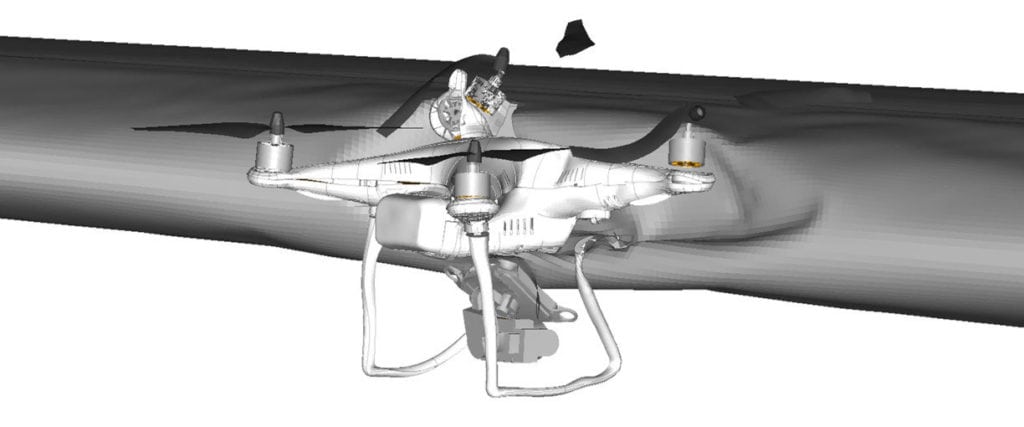
Quadcopter wing impact. Photo courtesy of ASSURE
When an unmanned aircraft system (UAS) struck a Beechcraft King Air 100’s wing last month in Canada, it showed that hypothetical “what-ifs” about the dangers of drones flying around manned aircraft aren’t actually hypothetical. It also makes the FAA’s Center of Excellence for UAS Research Alliance for System Safety of UAS through Research Excellence (ASSURE) final report on air-to-air, unmanned-to-manned collisions all the more significant.
ASSURE and the FAA announced Wednesday its report titled, “The sUAS Air-to-Air Collision Severity Evaluation Final Report,” which studies small drones, business jets and commercial jets. According to ASSURE, its research team began its research in fiscal year 2016 using unique resources from Mississippi State University, Montana State University, Ohio State University and Wichita State University. After determining the most likely impact scenarios by analyzing operating environments, the team selected the commercial and business aircraft and small drones “based on these impact scenarios and their likely exposure to one another,” ASSURE said.
“While the effects of bird impacts on airplanes are well documented, little is known about the effects of more rigid and higher mass [small UAS] on aircraft structures and propulsion systems,” said Mississippi State University’s Marty Rogers, the director of ASSURE. “The results of this work are critical to the safety of commercial air travel here in the United States and around the world.”
ASSURE said that since 70% of the commercial aircraft fleet is made up of narrow-body airframes (like the Boeing 737 and Airbus A320), the study focused on the impact of manned-unmanned collisions on that airframe type. On the business jet side, the highlighted airframe is one representative of a Bombardier Learjet 30/40/50. The study used small quadcopters and light fixed-wing drones since they are, according to ASSURE, the most-likely threats to fixed-wing aircraft. ASSURE researchers also determined leading edges of wings, vertical and horizontal stabilizers, and windscreen as the areas of manned aircraft most likely to be impacted by a small drone.
Through collision simulations, ASSURE found that collisions with small drones inflict more damage on an aircraft than collisions with birds. This means that some structural components designed by original equipment manufacturers (OEMS) to withstand bird strikes are not enough to withstand drone strikes. ASSURE said commercial aircraft OEMs design aircraft structural components to withstand bird strikes from birds up to eight pounds for the empennage and four pounds for windscreen. A drone strike of equivalent size and speed does more damage, as hardware components are stiffer than birds.
“Therefore, bird-strike certification regulations are not appropriate for unmanned aircraft,” ASSURE said. “Additionally, regulators do not require and manufacturers do not design commercial and business aircraft to withstand collisions from other aircraft.”
The ASSURE study looked at various levels of airframe and engine damage in all small drone collision simulations. It was found that energy (projectile mass and velocity) and the stiffness of the drone are the primary drivers of impact damage. That means the severity of the collision is partly dependent on the design features of the drone and the dynamics of the impact.
If a UAS that runs on lithium batteries collides with a manned aircraft, the risk of fire increases, ASSURE said. Researches conducted physical testing and simulation to find that during some low-speed impacts, associated with landing and takeoff, the battery remained lodged in the airframe and there was potential for increased risk of battery fire. However, at typical high speeds, the battery completely destructs and cancels any risk of battery fire due to a shorted battery.
Simulations were also performed exploring engine impact on the fan section of an existing business-jet-sized, turbofan-engine model that the FAA previously used for fan blade-out testing, ASSURE said. This research was conducted to better inform the scope of the next phase of research, as well as the critical variables essential to their continued research and engine ingest testing.
“Conducting this study through full-scale physical tests would not have been possible from a cost and time perspective due to the immense complexity of the task. On the other hand, simulation enabled us to study over 180 impact scenarios in a 12-month period,” said Gerardo Olivares, director of crash dynamics and computational mechanics laboratories at Wichita State University. “To ensure results accurately predict the actual physical behavior of collisions, we have spent a lot of time developing, verifying, and validating detailed models of manned and unmanned aircraft. Once the models are validated, we can use them in the future to investigate other impact scenarios.”
ASSURE said the FAA is depending on the drone industry to help develop the technology for detect-and-avoid so airborne collisions are few and far between. ASSURE is planning more research projects like this one. Future studies will assess the severity of collisions with general aviation aircraft, rotorcraft and high-bypass turbofan engines. These studies are to be broken into multiple phases beginning this year and running through fiscal year 2021.
Click here to view ASSURE’s report in its entirety.